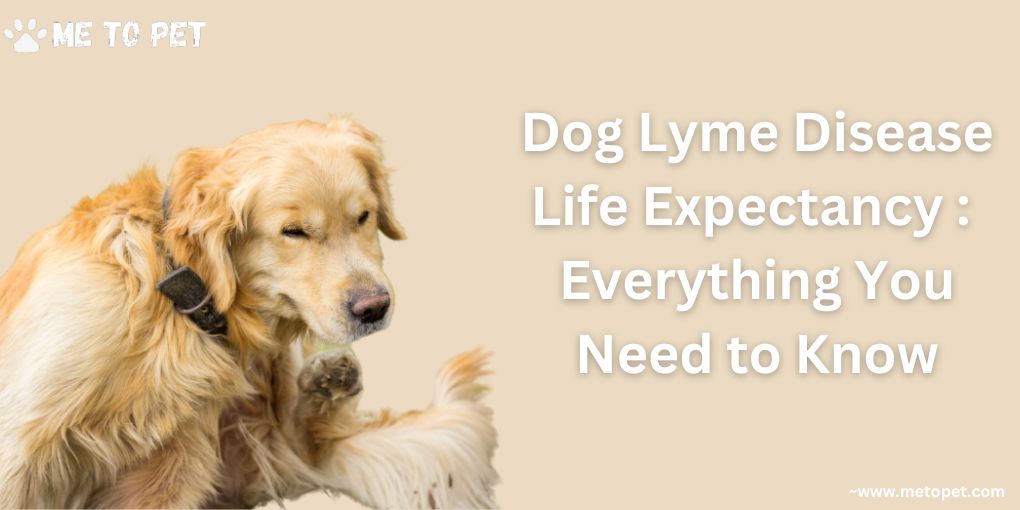
Pet dogs Lyme disease life expectancy is becoming crucial issue for pet parents.
While often associated with human cases, it’s crucial to recognize that dogs can also be affected by this tick-borne disease. As responsible pet owners, understanding the impact of Lyme disease on a dog’s life expectancy is crucial. That’s how you can provide them with the best possible care.
We will delve into the details of Lyme disease in dogs, including its symptoms, diagnosis, and treatment options. We will explore the factors influencing a dog’s life expectancy after being diagnosed with Lyme disease.
You’ll get to know the preventive measures you can take to protect your furry companions from tick infestations. You can reduce the risk of contracting this debilitating disease.
The purpose of this article is to equip dog owners with valuable information so they can
a) recognize the signs of Lyme disease,
b) seek timely veterinary care, and
c) make informed decisions about their dog’s treatment and overall well-being.
Stay informed to ensure your beloved canine friends lead healthier and happier lives.
Understanding Lyme Disease in Dogs
Lyme disease in dogs is a bacterial infection caused by the spirochete bacterium Borrelia burgdorferi. This disease is primarily transmitted through the bites of certain species of ticks. And the most common one is the deer tick and the western black-legged tick.
A dog gets bit by a sick tick, which feeds on the dog’s blood. Then the tick transmits the bacterium into the dog’s bloodstream, causing Lyme disease.
Common Symptoms and Clinical Manifestations
Early Signs
The symptoms of Lyme disease in dogs often appear within 2 to 5 months after a tick bite. Common early signs include lameness or stiffness, fever, lethargy, and decreased appetite.
Kidney and Joint Involvement
The disease can lead to more severe symptoms. Kidney problems and joint inflammation are some of them.
Neurological Issues
In rare cases, Lyme disease can affect the nervous system, leading to.
a)weakness,
b)uncoordinated movements,
c)and behavioral changes.
Diagnostic Methods and Early Detection
Blood Tests:
Veterinarians perform blood tests to detect antibodies against Lyme disease. The dog’s clinical signs and history of tick exposure are important to understand the results.
Polymerase Chain Reaction (PCR) Test:
PCR tests can be used to identify the presence of the bacterium’s genetic material. The test provides more reliable results, especially in the early stages of infection.
Early detection of Lyme disease is crucial for initiating timely treatment. The diagnosis can impact a dog’s quality of life.
Factors Affecting Life Expectancy
Several factors can influence a dog’s life expectancy after Lyme disease. Let’s try to understand them to extend dog Lyme disease life expectancy-
Timely Diagnosis and Treatment
Early Detection
Detecting Lyme disease in its early stages allows for timely intervention. The detection can prevent the infection from advancing to more severe complications.
Prompt Treatment
Starting treatment with appropriate antibiotics can help cut the bacteria. The treatment reduces the risk of long-term damage to organs and joints.
The Severity of the Disease and Its Progression
Intensity of Infection
How bad the disease is can depend on how far the bacteria have spread through the dog’s body. It also determines the level of damage to organs and tissues.
Response to Treatment
Some dogs may respond well to treatment and experience a full recovery. Yet, others may face persistent or recurring symptoms despite treatment.
Underlying Health Conditions and Age of the Dog
Pre-existing Health Issues
Dogs who already have health problems are more likely to get sick from Lyme disease. Some such health conditions are kidney disease or weakened immune systems,
Age
The age of the dog can also influence the prognosis. Puppies and older dogs may have immune systems that aren’t as strong, making them more likely to get sick.
Reinfection and Co-infections
Reinfection:
Dogs that have had Lyme disease before and have since gotten better could get it again. Be careful to let them be exposed to infected ticks again.
Co-infections:
Lyme disease is sometimes accompanied by other tick-borne infections. The co-infection can complicate the clinical picture and treatment plan.
Preventive Measures and Care
Tick Prevention
Taking proactive measures to prevent tick infestations can reduce the risk of contracting.
Supportive Care
Proper care, nutrition, and a comfortable environment can improve a dog’s well-being. A warm environment can also impact their response to treatment.
Always work closely with veterinarians to assess their dog’s condition. Also, remember to develop an appropriate management plan.
Address any changes in the dog’s health properly.
Treatment Options and Management
Treating Lyme disease in dogs involves a combination of antibiotics and supportive care. Early detection and medication are essential for better chances of a successful recovery.
Here are the key aspects of treatment options and management for dogs with Lyme disease:
Antibiotics and Their Effectiveness Against Lyme Disease
Doxycycline
This is one of the most prescribed antibiotics for treating Lyme disease in dogs. It is effective against the disease and helps eliminate the infection from the dog’s body.
Other Antibiotics
Veterinarians may use other antibiotics like amoxicillin or ceftriaxone in some cases. The medication depends on how bad the infection is and how well the dog responds to treatment.
Supportive Care and Symptom Management
Pain Relief
Dogs experiencing joint pain may benefit from pain medications. You can also provide them with anti-inflammatory drugs prescribed by the veterinarian.
Fluid Therapy
Where Lyme disease has caused kidney problems or dehydration, fluid therapy is impactful.
Long-term Outlook and Potential Complications
Follow-up Care
After completing the antibiotic treatment, regular follow-up visits with the veterinarian are essential. This way, you can check the dog’s progress and ensure the infection is resolved.
Chronic Symptom
Some dogs may suffer persistent symptoms even after treatment. In such cases, ongoing management and supportive care are necessary.
Precautions for Co-infections
Comprehensive Testing
Go for some extra tests if you suspect co-infections to identify quickly.
Tailored Treatment
As a pet owner, you must carefully follow the vet’s directions. Give them all the drugs prescribed to prevent further infection.
Emotional Support for Dog Owners
Knowing a Lyme disease diagnosis for your canine companion can be emotionally challenging. Coping with the news and navigating the treatment process can cause stress.
During this time, emotional support is essential for the dog and the owner. Here are some ways dog owners can seek and receive emotional support during their pet’s journey with Lyme disease.
Coping with the Diagnosis and Managing Emotional Stress
Reach Out to Supportive Friends and Family
Share with close ones who can offer a listening ear during challenging moments.
Talk to Other Dog Owners
Seek support from fellow dog owners who have experience dealing with Lyme disease. Online forums and social media groups can be valuable resources for connecting with them.
Seeking Support from Veterinarians and Support Groups
Discuss Concerns with the Veterinarian
Don’t hesitate to ask questions and seek clarification from the veterinarian. Try to understand the –
a) diagnosis,
b) treatment plan, and
c) prognosis for your dog.
A compassionate and informative veterinarian can ease anxieties and provide reassurance.
Join Support Groups
Consider joining local or online support groups dedicated to pet owners. Sharing experiences, advice, and encouragement is soothing for mental health.
Making Informed Decisions About Treatment and Care
Educate Yourself
Stay informed about Lyme disease, treatment options, and potential outcomes. If you know about the disease, you can make better choices.
Discuss Treatment Plans
- Engage in open discussions with the veterinarian about –
- treatment options,
- potential side effects, and
- long-term management.
- You can create a tailored care plan that suits your dog’s needs.
Providing Love and Comfort to Your Dog
Offer Comfort and Reassurance
Be there for your dog during the treatment process. Provide love and support to ease any stress they may experience.
Track Your Dog’s Behavior
Pay attention to changes in your dog’s behavior and mood. Communicate these observations with the veterinarian. Identifying any concerning signs early can lead to timely intervention.
Conclusion
Taking care of your emotional well-being is crucial for your dog. Don’t hesitate to seek professional support or counseling if needed.









